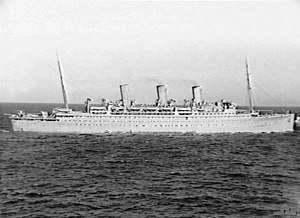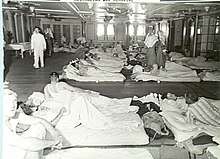RMS Empress of Canada (1920)
RMS Empress of Canada was an ocean liner built in 1920 for the Canadian Pacific Steamships (CP) by Fairfield Shipbuilding & Engineering Company at Govan on the Clyde in Scotland. This ship—the first of two CP vessels to be named Empress of Canada[2]—regularly traversed the trans-Pacific route between the west coast of Canada and the Far East until 1939.
 Empress of Canada | |
| History | |
|---|---|
| Name: | 1922–1943: RMS Empress of Canada |
| Owner: |
1922–1943: |
| Operator: |
|
| Port of registry: | 1922–1939: Canada |
| Ordered: | 1920 |
| Builder: | Fairfield Shipbuilding & Engineering Company, Govan, Scotland |
| Cost: | approximately $6,800,000 |
| Yard number: | 528 |
| Launched: | 18 August 1920[1] |
| Completed: | May 1922 |
| Maiden voyage: | 5 May 1922 |
| Fate: | Torpedoed and sunk, 13 March 1943 |
| General characteristics | |
| Type: | Ocean liner |
| Tonnage: | 21,517 GRT |
| Length: | |
| Beam: | 77.7 ft (23.7 m)[1] |
| Propulsion: | 6 steam turbines |
| Speed: | 18 knots (33 km/h) |
| Capacity: |
|
| Notes: | CPR's first ship to undertake a round-the-world cruise in December 1924 |
History
In 1920, Canadian Pacific Steamships ordered a new ship to be built by Fairfield Shipbuilding & Engineering Company at Govan near Glasgow in Scotland.[3] This Empress was a 21,517 ton, 653-foot ocean liner. The ship was launched 18 August 1920 with a notable speech by the general manager of the Canadian Pacific Ocean Services, Ltd., Sir Thomas Fisher, noted the approximately $6,800,000 price compared to a pre-war cost of about $2,200,000 and cost of operation that had risen at least 350 per cent had forced first class fares from $76 to $202 (based on a $4 to the pound sterling) and predicted dire consequences for shipping and the British Empire.[1] A world tour, planned for the spring of 1921, was cancelled due to labor disturbances making on-schedule completion doubtful.[4]
She undertook her maiden voyage on 5 May 1922. Based at the port of Vancouver, British Columbia, Canada, the first Empress of Canada was intended to provide service to Japan, Hong Kong, and China. She was at the time the largest vessel ever engaged in transpacific service.[5] Her sister ships included Empress of France and Empress of Britain.
Great Kantō earthquake
On 4 September 1923, Empress of Canada arrived at Tokyo harbor—just three days after the devastating Great Kantō earthquake struck the city. She found that the Canadian ocean liner RMS Empress of Australia had been converted to a command post from which the British consul was directing relief work, and the Empress of Canada transported refugees – 587 Europeans, 31 Japanese, and 362 Chinese – to Kobe, Japan.[6]
On 13 October 1929, Empress of Canada ran aground off Vancouver Island, British Columbia, Canada. Ninety-six passengers were taken off by tender and landed at Victoria, British Columbia. She was refloated on 15 October and towed to Esquimalt, British Columbia, for drydocking.[7][8]
World War II
Following the outbreak of World War II in 1939, she was converted for use as a troopship. She was one of the ships in the first Australian/New Zealand convoy, designated US.1 for secrecy, destined for North Africa and at that time not yet fully converted for full troop capacity with few ships of the convoy carrying more than 25% more than their normal passenger load.[9] Empress of Canada departed Wellington 6 January 1940 with the New Zealand elements, joined the Australian ships and arrived in Aden on 8 February from where the convoy split with all ships heading for Suez.[9]

She continued to transport ANZAC troops from New Zealand and from Australia to the war zones in Europe until sunk. The return voyage from Europe was not less dangerous than the trip north had been. On 13 March 1943, while en route from Durban, South Africa to Takoradi carrying Italian prisoners of war along with Polish and Greek refugees,[10] the SS Empress of Canada was torpedoed at midnight and sunk by the Italian submarine Leonardo da Vinci approximately 400 miles (640 km) south of Cape Palmas off the coast of Africa. Of the approximate 1800 people on board, 392 died. Nearly half of the fatalities reported were Italian prisoners.[11] British rescuers saved 800 of those aboard.[12]
See also
- CP Ships
- List of ocean liners
- List of ships in British Columbia
Notes
- Pacific American Steamship Association; Shipowners Association of the Pacific Coast (1920). "European Marine Developments". Pacific Marine Review. San Francisco: J.S. Hines. 17 (November): 87–88. Retrieved 11 May 2015.
- The second SS Empress of Canada (1961) was built for CP.
- Johnston, Ian. "Govan Shipyard" in Ships Monthly. Archived 11 June 2008 at the Wayback Machine June 1985.
- Pacific American Steamship Association; Shipowners Association of the Pacific Coast (1920). "Empress of Canada Tour Off". Pacific Marine Review. San Francisco: J.S. Hines. 17 (November): 111. Retrieved 11 May 2015.
- Pacific American Steamship Association; Shipowners Association of the Pacific Coast (1922). "The Empress of Canada". Pacific Marine Review. San Francisco: J.S. Hines. 19 (July): 412–413. Retrieved 11 May 2015.
- "All Ships Aiding Relief," New York Times. 9 September 1923.
- "Pacific liner aground". The Times (45334). London. 15 October 1929. col E, p. 16.
- "The Empress of Canada". The Times (45335). London. 16 October 1929. col F, p. 14.
- Gill, G. Hermon (1957). Royal Australian Navy 1939–1942. Australia in the War of 1939–1945. Series 2 – Navy. 1. Canberra: Australian War Memorial. pp. 85–94.
- Dictionary of Wrecks Archived 10 May 2017 at Wikiwix
- Jordan, Roger: The World's Merchant Fleets, 1939: The Particulars And Wartime Fates of 6,000 Ships. Naval Institute Press, 2006. Page 110. ISBN 1-59114-959-2
- Associated Press, “400 Lives Lost In Sinking of Liner Year Ago”, The San Bernardino Daily Sun, San Bernardino, California, Saturday 19 February 1944, Volume 50, page 2.
External links
| Wikimedia Commons has media related to Empress of Canada (ship, 1922). |
- The Role of the CP Ships in World War II
- New York Public Library Digital Gallery:
- NYPL ID 97714, unknown photographer: Empress, starboard view
- NYPL ID 97713, unknown photographer: Empress, portside view
- IWM Interview with survivor William Birch
- IWM Interview with survivor Mike Juni